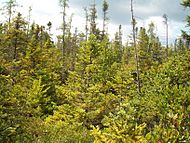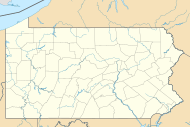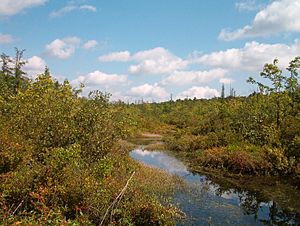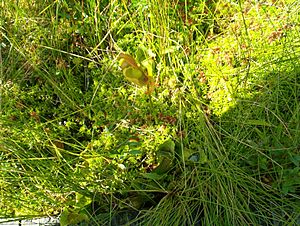Tannersville Cranberry Bog facts for kids
Quick facts for kids Tannersville Cranberry Bog |
|
|---|---|

Black spruce and tamarack trees growing near the bog's center
|
|
| Location | Tannersville, Pennsylvania |
| Area | 1,000 acres (400 ha) |
| Established | 1956 |
| Governing body | The Nature Conservancy |
| Website | |
| Designated: | 1974 |
The Tannersville Cranberry Bog, also called Cranberry Swamp, is a special type of wetland found in Tannersville, Pennsylvania. It's a unique sphagnum bog located along the Cranberry Creek. This bog is the most southern "boreal" bog east of the Mississippi River.
It's home to many black spruce and tamarack trees. These trees are usually found in colder, northern areas. The Tannersville Cranberry Bog is at the very edge of where they can grow. Even though it's called a bog, it's technically an "acid fen" because it gets some water from underground. In December 1974, it was named a National Natural Landmark. The Nature Conservancy and the Conservation and Research Foundation bought the land in 1957 to protect it.
Like many bogs, the ground might look solid, but it's actually a floating mat. Underneath a six-inch layer of sphagnum moss and tree roots is a soft, watery mass of decaying peat. Luckily, visitors can explore this amazing place from a special floating walkway.
Contents
How the Tannersville Cranberry Bog Formed
The Tannersville Cranberry Bog started forming about 10,000 years ago. This was after the last Wisconsin Glacier began to melt and retreat. A large chunk of ice broke off and was left behind. As it melted, it created a deep "kettle lake." This lake was once as deep as the tops of the trees you see today.
Over thousands of years, sphagnum moss began to grow out from the edges of the lake. It slowly spread across the water's surface. This moss created a thick layer of peat, which is made of decaying plants. The peat layer in the bog is now over 40 feet (12 meters) thick! Young bogs sometimes have an "eye" of open water in the middle, but the Tannersville Cranberry Bog is now completely covered. However, a narrow strip of open water still shows where the Cranberry Creek flows. The water in the creek is less acidic than the bog water.
Plants of the Bog: Flora and Unique Adaptations
The Tannersville Cranberry Bog is home to many interesting plants. Some of these plants are very rare in Pennsylvania. They have special ways of living in the bog's wet, acidic soil.
- Sphagnum Moss: This is the most important plant in the bog. It forms a thick, spongy mat that covers the water. It also makes the bog water very acidic.
- Conifer Trees: These trees have needles instead of leaves.
- Black spruce: A type of evergreen tree that grows well in cold, wet places.
- Tamarack: Also called "American larch," this is a unique conifer. Its needles turn a bright yellow in the fall before they drop off.
- Heath Plants: These are small, woody shrubs that thrive in acidic soil.
- Highbush blueberry
- Leatherleaf
- Cranberry
- Sheep laurel
- Bog-laurel
- Swamp azalea
- Rhododendron
- Bog rosemary
- Swamp loosestrife
- Beggar's tick
- Parasitic Plants: These plants get their food from other plants.
- Grasses: You can find different types of grasses in the bog.
- Sedges: Grass-like plants that grow in wetter, more nutrient-rich areas.
- Cotton grass: Has fluffy, white seed heads that look like cotton.
- Yellow-eyed grass
- Insectivorous Plants: These amazing plants "eat" insects to get nutrients they can't find in the bog's soil.
- Pitcher plant: Has a cup-shaped leaf that traps insects.
- Sundew: Has sticky hairs on its leaves that trap insects.
- Sun-loving Plants: These plants need a lot of sunlight. They are slowly being replaced by the heath plants as the bog changes over time.
- Labrador tea
- Golden-club
- Hartford fern
- Orchids: Beautiful and rare flowers.
- Grass pink
- White-fringed orchid
- Rose pogonia
- Yellow lady's slipper
- Heart-leaf twayblade (not seen recently)
- Other Plants:
- Wild calla
- Gold thread
- Winterberry
- Sumac
- Poison sumac
- Poison ivy
Animals of the Bog: Fauna and Wildlife
The Tannersville Cranberry Bog is also home to many different animals. Some of these animals are rare or endangered. They rely on the bog's unique environment for food and shelter.
- Mammals:
- Black bear
- Bobcat
- Coyote
- Gray fox
- Mink
- River otter (found in Cranberry Creek)
- Rodents:
- Birds: Many birds use the bog for breeding and raising their young.
- Other Animals:
- Bog turtle: A small, endangered turtle.
- Pickerel (a type of fish found in Cranberry Creek)
- Crayfish (found in Cranberry Creek)
- Bog copper butterfly: This butterfly is endangered and lives only in bogs.
Protecting the Bog
The idea to protect the Tannersville Cranberry Bog started with William A. Niering. As a child, he visited the bog often because his uncle owned it. He grew up to become a famous expert on bog ecosystems. The bog's importance became very clear during the Flood of 1955. Bridges downstream from the bog were saved from damage. This showed how important wetlands are for controlling floods.
In 1956, The Nature Conservancy bought the first 62.5 acres (25.3 hectares) of the bog to protect it. Since then, the protected area has grown to over 1,000 acres (405 hectares) through gifts and purchases. This protected land also connects to other public lands, making a larger natural area.
Visiting the Bog
At first, people were not allowed to visit the bog. However, in the 1980s, the Monroe County Conservation District worked to open the bog for public education. They wanted people to learn about this special place.
A floating boardwalk was built to allow visitors to explore the bog safely. It was expanded in 1993 to 1,450 feet (442 meters) long. The boardwalk is made of treated lumber supported by floating barrels. Now, when planks need to be replaced, they use a special recycled plastic material. This helps protect the environment even more.




